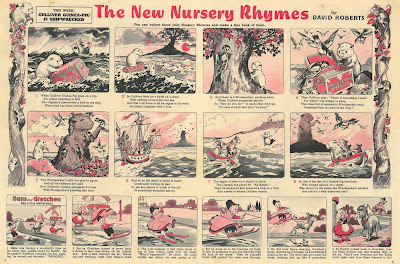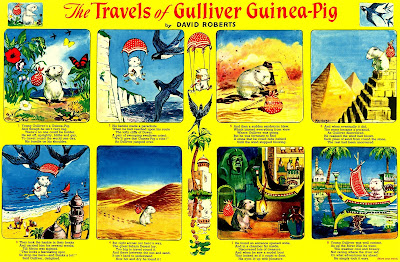The First Steps of an Unlikely but Very Likeable Hero:
Gulliver Guinea-Pig (Part 2)
by
John Wigmans
As
it turns out, Gulliver didn’t start his travels in Playhour dated 24 May 1958
(No. 189). As far as I now know, his real debut was in Tiny Tots dated 17 May
1958 (No. 1298), as part of The New Nursery Rhymes. The tiny traveller also
featured in an illustrated but uncredited three-page story included in the Tiny
Tots Annual for 1959. Annuals were prepared many months before publication, and
I am quite sure the text and the drawings were completed in the spring of 1958.
This annual went on sale in September/October 1958, but it was presented as the
annual for 1959.
Furthermore,
I think that these three earliest adventures of the little explorer were
written and illustrated almost simultaneously, within a couple of weeks, days
even, most likely in March or April 1958. Which story really was the first to
be produced – the true genesis of Gulliver Guinea-Pig, is of little importance.
Unless other information surfaces, Gulliver made his first steps in the
following publications (in chronological order):
-
Tiny Tots dated 17 May 1958, No. 1298;
-
Playhour dated 24 May 1958, No. 189;
-
Tiny Tots Annual for 1959, on sale in September/October 1958.
All
of these stories were written by David Roberts and beautifully illustrated by
Philip Mendoza. It is easy to see why Steve Holland wrote the following words
about the artist and his contributions in Playhour on his BearAlley-blogspot: “Mendoza quickly found his forte, drawing a
number of cover illustrations of anthropomorphic animals, a hugely popular
sub-genre of nursery comics which often took the everyday and turned it into
something magical. Animals with human characteristics had been a staple of
British comics since the 1920s and the huge success of ‘Tiger Tim’. However,
Mendoza’s were not the rounded, cartoony animals of Herbert Foxwell, nor the
delicate water-coloured bunnies of Beatrix Potter, they were the more robust
creatures of Ernest Aris. They had the spikes and ruffled fur of creatures that
looked as if they could have actually just come from a hedgerow or corn field.”

Steve
continued: “In 1958, David Roberts, the
assistant editor of Playhour, created a new character for the weekly paper’s
back page, ‘Gulliver Guinea-Pig’, a roving world-traveller whose adventures on
and off the map would run in the comic for over seven years. Roberts’ vivid
imagination took Gulliver to countries around the globe, visiting friends and
relatives and seeking adventure or warmth from a harsh winter. Once he had
visited everywhere from Japan to darkest Africa, Roberts sent Gulliver to meet
the inhabitants of Long-Ago Land, Rainbow Land and Nursery Rhyme Land. Over the
years, Gulliver would climb Everest, fly to the Moon, fall through the screen
of his TV and visit the land of fairy tales... all beautifully depicted by
Phillip Mendoza in full colour until the strip was taken over by Gordon
Hutchings in 1961.” (BA-blogspot, March 6, 2007: Philip Mendoza [Montague
Phillip Mendoza])
Steve
was equally clear about the skills of David Roberts: “The author of Gulliver was David Roberts, one of the unsung writers of
British comics who was responsible for many of the best strips in Playhour,
including a lot of centre-spread series and a number of other favourites like
‘Leo the Friendly Lion’ and ‘Princess Marigold’. Roberts had a marvellous flair
for writing verses with just the right lightness of touch that worked so well
with strips like Gulliver. The later strips had descriptive captions typical of
the other strips in Playhour, one of the reasons why the early years of
Gulliver are such a favourite. Coupled with the artwork by Philip Mendoza, the
strip has an effervescence and charm that hasn’t been seen in comics for too
long.” (BA-blogspot, December 23, 2006: Gulliver Guinea-Pig’s Happy
Christmas)
And
from Steve’s latest book, Forgotten Authors Volume 2, I took the following
blurb: “David Roberts: Writer behind the
weekly adventures of world travelling Gulliver Guinea-Pig and fairy tale heroine
Princess Marigold, Roberts helped entertain and shape the minds of millions of
youngsters as both a scriptwriter and creator of children’s magazines.”
(BearAlleyBooks-blogspot, February 2, 2018).
Well,
now we know that originally Gulliver was not created for Playhour. It is
unclear (to me at least) why the strip was transferred so quickly from Tiny
Tots to its companion paper. Six instalments of The Travels of Gulliver
Guinea-Pig by the Roberts/Mendoza-team on the centre pages of Playhour (Nos. 189-194),
in beautiful colours and with rhyming captions, were only the beginning of a long
run in this nursery comic.
For
over seven years the exciting adventures of our ‘roving world-traveller’
appeared on the back cover and the centre pages of Playhour. Those stories,
however, are outside the scope of this article. I can only hope that Irmantas
lives up to the promise he made here, on his own blogspot (January 5, 2018): “The quality of the artwork and the stories
makes me want to do a detailed account of all Gulliver’s travels during the
seven years of the strip’s existence (1958 – 1965)…” Then please do not
forget to include the ‘prequels’ in Tiny Tots No. 1298 and the Tiny Tots Annual
for 1959.
By
the way, in spite of the revamp in October, 1957, Tiny Tots didn’t survive for
long. Early 1959 the comic was incorporated with its companion paper Playhour.
Apparently much to his regret, Bill Lofts wrote the following words about the
demise of the weekly in The Collectors’ Digest of February 1959, No. 146:
As a
special treat, here is a scan of another strip from the pages of Tiny Tots,
again beautifully illustrated by Mendoza. He really was at the top of his game
at the time. On the back page of No. 1327 (6 December 1958) young readers would
find an episode of ‘The Town Mouse in the Country’. These lovely tales began in
No. 1308 (26 July 1958), in full colour up to No. 1327 at least. Towards the
end of Tiny Tots this strip was moved to an interior page and probably appeared
in black-and-white and grey-wash. The last issue (No. 1334) had the adventures
of Katie and her cousin Matilda on page 6.
Additional
information and corrections are appreciated. A photograph of Philip Mendoza,
taken in or around 1958, would be most welcome.











lovely...great to see beautiful artwork and writing..
ReplyDelete"In 14 hundred and 92 gulliver guinea-pig discovered Peru"
ReplyDelete"Drinking steaming cups of cocoa on the river Orinoco"
Helped me pass gce history and geography ha ha ha. Magical!